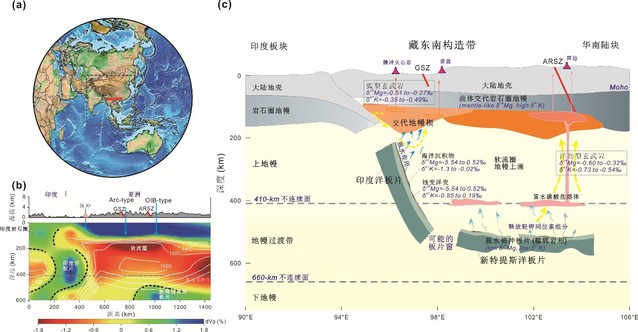Qiong Chen1, Hao Cheng1, GuoChun Zhao2, MeiFu Zhou3, PingPing Liu4, WenJun Li5, and Min Sun2
1 State Key Laboratory of Marine Geology, Tongji University, Shanghai, China
2 Department of Earth Sciences, the University of Hong Kong, Pokfulam Road, Hong Kong, China
3 State Key Laboratory of Critical Mineral Research and Exploration, Institute of Geochemistry, Chinese Academy of Sciences, Guiyang, China
4 SKLab-DeepMinE, MOEKLab-OBCE, School of Earth and Space Sciences, Peking University, Beijing, China
5 Key Laboratory of Mineral Resources, Institute of Geology and Geophysics, Chinese Academy of Sciences, Beijing, China
Abstract: The Tibet peaked due to the incorporation of slab materials and intensive mantle-crust interaction. It remains uncertain regarding the differentiated mantle enrichment and elemental cycling process in a post-collisional setting. Here, we use stable Mg-K isotopic data from young (< 5 Ma) arc-type and OIB-type basalts-spatially and genetically linked to slab subduction and stagnation-to quantify the origin, proportion, and transport mechanism of materials contributing to mantle heterogeneity. Both basaltic types from southeast Tibet possess homogeneous and low δ26Mg values (-0.39 ± 0.03‰ to -0.36 ± 0.04‰) compared to the normal mantle range (δ26Mg = -0.25 ± 0.04‰); Mg-Sr-Nd-Pb isotopic mixing models suggest that isotopically light marine carbonates were incorporated into the mantle wedge and mantle transition zone (MTZ). In terms of the isotopic dataset of post-collisional magmatic rocks, pervasive carbonatitic metasomatism served as the deep carbon source that enhanced mantle heterogeneity. Compared to the mantle-like δ41K (-0.49 ± 0.04‰ to -0.35 ± 0.02‰) of arc-type samples that re-homogenized in the wedge, the OIB-type lavas have variable δ41K values (-0.73 ± 0.03‰ to -0.54 ± 0.02‰) lower than those of primitive mantle (δ41K = -0.42 ± 0.08‰), suggesting an increased release of isotopically light K from dehydrated Neo-Tethyan slab residues that stagnated in the MTZ. Geophysical evidence supports that these deep-seated metasomatic agents triggered wet upwelling flows atop the MTZ and transported surficial materials back via volcanism. Critically, this study constrains the origin of mantle heterogeneity and material circulation triggered by various contributions of the subducted plate.
Full article:https://doi.org/10.1016/j.gca.2025.10.010



